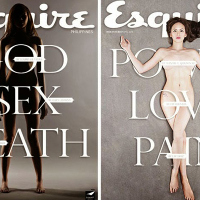It was a killing planned for maximum brutality: The simultaneous beheading of 22 Syrian captives held by ISIS.
In November, ISIS released a propaganda footage titled “Though the Unbelievers Despise It.” It featured the apparent murder of an American hostage, Peter Kassig (known as Abdul Rahman Kassig after his conversion to Islam), and the mass killing of what appear to be nearly two dozen Syrian soldiers.
The US-based terrorism research organization TRAC (Terrorism Research & Analysis Consortium) and UK-based counter-extremism think tank Quilliam have analyzed the footage frame-by-frame to understand the video’s production techniques, the identity of the hostages and their killers, and the visual significance of such calculated brutality.
Investment in terror: Experts believe the 16-minute long video would have cost ISIS approximately $200,000 to produce, such was the sophistication of the editing equipment required and the quality of the multiple HD cameras needed to produce such a slick and professional piece of propaganda.
According to joint research carried out by TRAC and Quilliam and published by CNN, events leading to ISIS’ horrific beheading of 22 Syrian soldiers were filmed over a four to six hour period.
Close analysis of shadows and the direction of sunlight suggests that scenes that appear to have been shot without pause were in fact broken up and filmed over a number of hours.
Horror: New evidence suggests ISIS’ killer-in-chief ‘Jihadi John’ (left) may have been played by a body double.
Other than the killer known only as Jihadi John, all of the ISIS militants who appear in the murder video are seen with their faces uncovered, making no attempt whatsoever to conceal their identity.
Despite this, only one of the terrorists featured has been formally identified - 22-year-old Frenchman Maxime Hauchard, who friends described as a mild-mannered former Catholic who used to sell scooter parts in Normandy until his conversion to Islam at the age of 17.
Although the names of a second Frenchman, Michael Dos Santos, and Belgian national Abdelmajid Gharmaoui have been put forward as other suspected executioners, official confirmation has not been given by either government.
Mystery: In fact the mayor of Vilvorde, the town where Gharmaoui lived before travelling to Syria in 2012, said Gharmaoui ‘is not at all in the video’, adding that claims to the contrary are ‘completely wrong’
In fact the mayor of Vilvorde, the town where Gharmaoui lived before travelling to Syria in 2012, said Gharmaoui ‘is not at all in the video’, adding that claims to the contrary are ‘completely wrong’.
‘We don’t recognise anyone from Vilvoorde in it,’ Hans Bonte said. ‘I can be sure 99 per cent that no-one from Vilvoorde is in it,’ he added.
Another name put forward as a suspect was Cardiff medical student turned Islamic State militant Nasser Muthana, 20. However video experts ruled that although the man in the clip resembles Muthana, there are subtle facial differences that suggest they are not the same person.
Callous: Kurdish sources familiar with the movement of ISIS militants in Syria and Iraq identified this unnamed killer from the latest ISIS beheading video as a Filipino national.
Meanwhile Kurdish sources familiar with the movement of ISIS militants in Syria and Iraq also identified one of the men as a Filipino national.
Since the release of the footage, analysts from Britain, France, Germany, the U.S., the Middle East, Asia, Australia and New Zealand have been poring over the footage to try and put names to faces.
News source: Daily Mail















